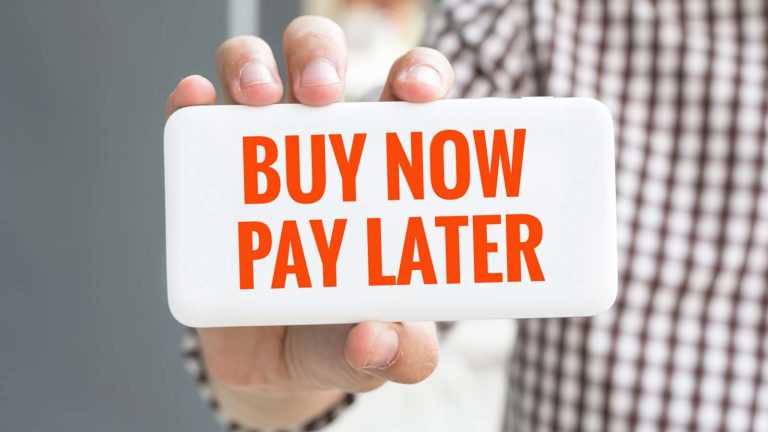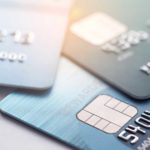Editorial Note: InvestorPlace Beacon independently determines what we cover and recommend. We earn a commission from affiliate partners on many offers and links. However, these commissions do not affect our editors' opinions or evaluations. Click here to read our full advertiser disclosure.

Source: Shutterstock
For decades, shopping worked pretty much the same way: “Credit or debit?” But this decade has brought us a third option: Buy Now, Pay Later (BNPL).
Now BNPL is popping up everywhere from Neiman Marcus to Walmart:
- At online retailers who’ve signed deals with BNPL companies: “This Versace watch would cost you $2,995 now…or payments start at $187 with Affirm!”
- In person, at the checkout line: Walmart also signed a deal with Affirm that lets you BNPL on the self-checkout screen.
- Through the BNPL company’s app: You apply for credit and receive an “estimated amount available to spend.” This credit can then be applied to online shopping purchases it recommends to you.
How Does BNPL Work?
Buy Now, Pay Later is credit, most often in the amount of a specific purchase, which is paid in installments over a relatively short timeframe. Affirm and Klarna are two of the big providers, along with Afterpay (a subsidiary of Square), PayPal and Synchrony.
When a retailer invites you to “Pay in 4,” that’s the best-known form of BNPL. It’s an interest-free form of credit that splits the sticker price into four equally sized payments.
Let’s say you’re looking to buy a Samsung smart TV priced at $598. You can Pay in 4 with $149.50 now, then typically the second, third and fourth installments of $149.50 each would be spaced two weeks apart.
If that still sounds like too much, the BNPL company may let you break it up into monthly installments instead; that typically does involve some form of interest.
On Walmart.com, for example, you can buy that Samsung TV using Affirm at an annual percentage rate (APR) of 20% and choose from these monthly options:
| Payment | Term Length | Interest Paid | Total Cost |
| $55.40/month | 12 months | $66.74 | $664.74 |
| $38.73/month | 18 months | $99.10 | $697.10 |
| $30.43/month | 24 months | $132.39 | $730.39 |
So — like putting it on a credit card — you end up paying about 20% more for that same TV, depending on how long you stretch out the payments.
Late payments with BNPL will result in “fees often around $7 per missed payment on an average loan size of $135,” according to the Consumer Financial Protection Bureau (CFPB). That’s about 5%, which is actually pretty high compared to carrying that balance on a credit card for one month, which might just result in about 2% interest…
But importantly, it’s a fixed dollar amount, and your balance never compounds with Pay in 4. Plus, BNPL normally puts you on autopay from your debit card or bank account, in which case you avoid late fees entirely.
BNPL has a couple of unique features that set it apart from other installment loans:
- BNPL is much quicker to apply for – just fill in your name, contact info, and maybe the last four digits of your Social Security Number.
- BNPL is often not reported to credit bureaus. So, if you’re looking to build credit, then making BNPL payments won’t help you if they’re not reported.
Even if BNPL loans do appear on your credit history, they still might not help you if you already have established credit. Now you have more lines of credit that don’t have a very long history. Before that, you might have had a longer average age of account, which can help you get a better credit score.
To really understand what we’re getting into with this brave new world of BNPL, it never hurts to ask:
How Do BNPL Companies Make Money?
As the saying goes, if something is free, then you’re the product.
Just like Big Tech companies, particularly Facebook and Google, became infamous for selling your personal data to advertisers…“Fintech” companies like those in the BNPL industry make money off your usage, too.
In this case, BNPL companies charge retailers a fee on each transaction of the four (or more) installments you pay over time.
Digging into Affirm’s financials, it’s clear these transaction fees are traditionally where BNPL companies make most of their money – although recently, they’re making just as much off of interest:
Back in December 2021, for instance, Affirm made about $153 million from merchant network revenues plus its virtual card, and it made $138 million in interest income. But in the most recent quarter, Affirm reported $227 million from merchant network revenues and the virtual card… but $288 million in interest income.
This suggests that the monthly payment plans are becoming just as popular as Pay in 4.
BNPL companies will do what they can to get people to keep spending, thus making more money on more transactions. And clearly, it works. If it didn’t, all these brands – Target, Home Depot and Lowe’s, even Armani and Oscar de la Renta – would never sign deals with BNPL providers.
Instead of being a rough deal for the retailer, BNPL companies can promise a higher “average order value.” Plus, at Affirm specifically, the rise of BNPL pushed average transactions per customer from two to four in just over a year.
Buy Now, Pay Later, But Use Sparingly
Even if you stick with the Pay in 4 option and avoid interest charges, there are other ways that BNPL companies can “get you,” if you’re not careful…
And that’s through what the CFPB calls “loan stacking” and “sustained usage.”
Basically, the BNPL industry is incredibly good at getting you to keep shopping, no matter what.
- When you log in to check on your account, the app will suggest similar items you might want to buy.
- And when they phrase it as fitting into your “estimated amount available to spend,” that sounds a lot better than “available credit to keep borrowing more and more with us.”
- Then their email marketing engine keeps hammering home all the deals out there you’re just going to love.
The difference between this and other offers getting thrown your way is that it’s easy to “stack” purchases and feel like you spent a normal amount of money…but you’re on the hook for much more.
Maybe you add one item to your cart that’s $125, but with Pay in 4, you can pay $31 for now. So, you Pay in 4 again to get another item you’ve been meaning to buy. That one costs $47 for your initial payment. And why not another Pay in 4 of just $28 upfront so you can add on another item that catches your eye?
That’s just $106 now… But ultimately, you end up paying $425 instead of the $125 you were originally planning to spend.
And once you’ve gone down this road, you might find it hard to kick the habit. It’s natural, because you won’t necessarily want to make a normal, full-price purchase when all the rest of your BNPL payments are looming…waiting to hit your bank account.
So, ironically, Buy Now, Pay Later is best used very differently than what these companies are advertising to repeat customers:
Rather than smaller, everyday purchases you come across in online stores or email offers… BNPL is best used for big-ticket, infrequent purchases.
Let’s say you get home one day to find that your beloved dog has had a bout of separation anxiety and shredded your couch cushions. Now where are your guests supposed to sit?
You head to Wayfair or IKEA, which are bound to have a couch you like for a few hundred dollars. That’s more than you might want to pay out of the blue now – but not a “budget buster” in the big picture. You Pay in 4… and now you’ve saved a lot on the interest you might otherwise accumulate with a credit card.
If you’ve been looking at engagement rings, that could be another ideal use of BNPL if you can pay less interest (or no interest at all) than with a credit card. BNPL can even be preferable to the “deferred interest plans” that big-ticket retailers love to promote, such as “12 months interest free.” With those, if you still hold a balance after the term ends, “you will be charged interest for each month on the balance you owed in each of the 12 months,” as the CFPB explains.
On the flip side, if BNPL deals are going to have you buying jewelry or home decor impulsively, rather than intentionally… That’s where they can get you into just as much trouble as other forms of credit.
Plan ahead, then proceed as planned, is always the name of the game when it comes to your bank account.
Sources:
BusinessWire. (2023, Dec. 19). Affirm Expands to Self-Checkout at Walmart Stores. Retrieved from https://www.businesswire.com/news/home/20231219776531/en.
U.S. Consumer Financial Protection Bureau. (2022, September). Buy Now, Pay Later: Market trends and consumer impacts. Retrieved from https://files.consumerfinance.gov/f/documents/cfpb_buy-now-pay-later-market-trends-consumer-impacts_report_2022-09.pdf.
Kleinbard, Martin and Udis, Laura. (2022, June 15). Buy Now, Pay Later and Credit Reporting. Retrieved from https://www.consumerfinance.gov/about-us/blog/by-now-pay-later-and-credit-reporting/.
Fair Isaac Corporation. (2023). Understanding FICO® Scores. Retrieved from https://www.ficoscore.com/ficoscore/pdf/Understanding-FICO-Scores.pdf.
Seeking Alpha. (2024, Feb. 8). Affirm Holdings, Inc. 2024 Q2 – Results – Earnings Call Presentation. Retrieved from https://seekingalpha.com/article/4668891-affirm-holdings-inc-2024-q2-results-earnings-call-presentation.
U.S. Consumer Financial Protection Bureau. (2024, Jan. 22). I got a credit card promising no interest for a purchase if I pay in full within 12 months. How does this work? Retrieved from https://www.consumerfinance.gov/ask-cfpb/i-got-a-credit-card-promising-no-interest-for-a-purchase-if-i-pay-in-full-within-12-months-how-does-this-work-en-40/



